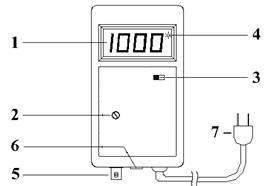| |
Micom Liquid Feeder Series |
| |
CS077-2 |
Operation Manual
ORP Controller |
|
| |
|
|
1.AC100 - 240V full-voltage.
2.BNC connector be suitable for every electrode.
3.A rack attached to body can be hanged on the tank.
|
| Model |
CS077-2 |
| Power
supply |
AC100V
¡ã 240V 50¡þ60 Hz |
| Measurement |
-1999mV ¡ã +1999mV
|
| Resolution |
1 mV |
| Accuracy
at 25¢XC |
¡Ó¡£0.1%+
2 digits¡¤ after calibrating |
| Impedance |
 ohms ohms |
| Set
Range |
-500mV ¡ã +500mV |
| Calibration
Knob |
None external |
| Relay
Contact |
5A
for 240VAC |
| Control
Output Voltage |
Same
as plug in AC voltage |
| Display |
0.56"
LED, digits digits |
| Operating
Temperature |
0¢XC
¡ã 50¢XC ¡£32¢XF ¡ã 122¢XF¡¤ |
| Operating
Humidity |
Max.
90% |
| Power
Consumption |
Approx.
2 watts |
| Dimension |
150
x 85 x 40 mm ¡£5.9 x 3.4 x 1.6 inch¡¤ |
| Standard
Accessories |
Instruction Manual, Adjustment Sticker, Instrument Holder
each one. |
| |
 |
|
ORP electrode input BNC terminal can only connect with ORP electrode, it is not allowed to connect with any other electrode. |
|
1.Display.
2.Set adjustment knob.
3.ORP¡þSET function switch.
4.Indicator of output in action.
5.Electrode BNC input terminal.
6.Control output socket ¡£Normal Open¡¤.
7.Power plug.
|
|
 |
| 1. |
|
Connecting AC power supply. ¡£Make sure the correct voltage.¡¤ |
|
| 2. |
|
Connecting the ORP electrode into the ORP input terminal socket. |
|
| 3. |
|
Turn the ORP/SET switch to "ORP" position. |
|
| 4. |
|
Take away the ORP electrode from storage bottle, and clean the electrode with distilled water, then place the electrode into the water. |
|
| REMARK¡G |
|
The controller is already calibrated ¡£base on 25¢XC environment¡¤. It needs not to make calibration any more. Please contact with your dealer where you buy when the calibration is necessary to apply. |
|
|
Instruction For Cleaning & Maintenance |
|
| 1. |
|
The
immersed level for electrode should not be higher
than the electrode cap. ¡£When use the refillable
electrode, the level should be lower than filling
open to avoid the water entering into the open
and cause damage.¡¤ It had better cleaning the
ORP electrode sensor with soft brush every 2 ¡ã
3 weeks to keep the test accuracy. Please keep
the electrode in the storage bottle with 3M KCL
buffer solution; the crystallization is normal
for the keeping. |
|
| 2. |
|
ORP
electrode is accurate glass product, please do
not knock it, and do not use finger, cloth and
alcohol to clean it to avoid the damage. |
|
| 3. |
|
There
is protection "dead band" for delaying output
control in "turn on" and "turn off" to avoid frequent
switching. |
|
|
|
|
Why Shouls We Know ORP ¡£Oxidation Reduction Potential¡¤
Range |
To realize
it by easy understanding aquarium concepts, The high
or low value of ORP shows higher or lower capacity which
can oxidize toxic ammonia and nitrite in water ¡£but
also oxidize the other materials in water¡¤! In short,
more pollutants in fish tank, ORP value is relative
lower; and is often higher for less pollutant situation.
¡´A well keeping coral reef aquarium
The reference reading of ORP could be between 360 ¡£just lighted up¡¤
and 450mV ¡£duration of switching light off¡¤.
¡´A well keeping freshwater plant aquarium
The reference reading of ORP could be between 250 ¡£morning or just
turn the light up¡¤ and 400mV or even higher ¡£evening or just turn the light
off ¡¤, ¡£normally the higher ORP reading shows for lower fish population,
and the lower reading shows for higher population.¡¤
¡´The denitrifying reaction chamber or filter.
The reference reading of ORP should be between -190 and 50mV. ¡£to
avoid produce the poisonous hydrogen sulfide in over reduction, the ORP
value should not be below -190mV¡¤. |
|
The Common Situation In Higher Polluted Aquarium |
|
| The common situation is lower ORP value in higher polluted aquarium and the value is not easy to be shifted up. The common ways to take to shift the ORP value up: Use ozone generator, protein skimmer, effective trickle filter or oxygen tower to increase the dissolved oxygen in water, add additives to increase the oxidation potentials |
|
|
|
|
|